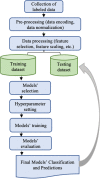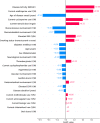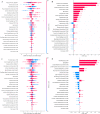Development of machine learning models for detection of vision threatening Behçet's disease (BD) using Egyptian College of Rheumatology (ECR)-BD cohort
- PMID: 36803463
- PMCID: PMC9938580
- DOI: 10.1186/s12911-023-02130-6
Development of machine learning models for detection of vision threatening Behçet's disease (BD) using Egyptian College of Rheumatology (ECR)-BD cohort
Abstract
Background: Eye lesions, occur in nearly half of patients with Behçet's Disease (BD), can lead to irreversible damage and vision loss; however, limited studies are available on identifying risk factors for the development of vision-threatening BD (VTBD). Using an Egyptian college of rheumatology (ECR)-BD, a national cohort of BD patients, we examined the performance of machine-learning (ML) models in predicting VTBD compared to logistic regression (LR) analysis. We identified the risk factors for the development of VTBD.
Methods: Patients with complete ocular data were included. VTBD was determined by the presence of any retinal disease, optic nerve involvement, or occurrence of blindness. Various ML-models were developed and examined for VTBD prediction. The Shapley additive explanation value was used for the interpretability of the predictors.
Results: A total of 1094 BD patients [71.5% were men, mean ± SD age 36.1 ± 10 years] were included. 549 (50.2%) individuals had VTBD. Extreme Gradient Boosting was the best-performing ML model (AUROC 0.85, 95% CI 0.81, 0.90) compared with logistic regression (AUROC 0.64, 95%CI 0.58, 0.71). Higher disease activity, thrombocytosis, ever smoking, and daily steroid dose were the top factors associated with VTBD.
Conclusions: Using information obtained in the clinical settings, the Extreme Gradient Boosting identified patients at higher risk of VTBD better than the conventional statistical method. Further longitudinal studies to evaluate the clinical utility of the proposed prediction model are needed.
Keywords: Behçet’s disease; Machine learning; SHAP analysis; Vision-threatening BD.
© 2023. The Author(s).
Conflict of interest statement
The authors declare that they have no competing interests.
Figures




References
-
- Zhang Z, Peng J, Hou X, Dong Y. Clinical manifestations of Behcet’s disease in Chinese patients. APLAR J Rheumatol. 2006;9(3):244–7. doi: 10.1111/j.1479-8077.2006.00208.x. - DOI
Publication types
MeSH terms
LinkOut - more resources
Full Text Sources
Medical

